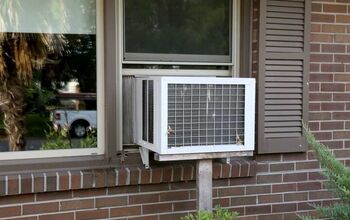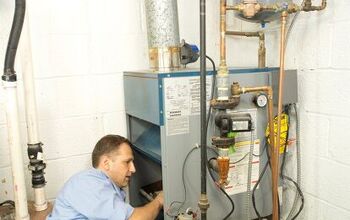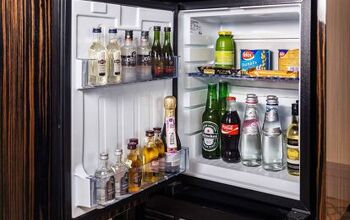Refrigerator Making Clicking Noises? (Possible Causes & Fixes)

Refrigerators are a big investment and a critical part of any home. Unsettling sounds can often puzzle homeowners and indicate a bigger problem with your refrigerator. So, why is your refrigerator making clicking noises?
Refrigerators generally make clicking noises if the condenser coils are dirty or the start relay is damaged. Replace your defrost timer or the start relay if they are damaged because you cannot repair them. Clean your condenser coils once per year to prevent clicking noises and replace them if they are beyond repair.
Test components such as the start relay with a multi-meter to see if they still have continuity or need to be replaced. Clicking noises aren’t always a bad sign, but they often indicate that at least one component is faulty. Follow along as we explore why your refrigerator is making clicking noises.
Do You Need Appliance Installation or Replacement?
Get free, zero-commitment quotes from pro contractors near you.

Why is My Refrigerator Making Clicking Noises?
A refrigerator making clicking noises is generally due to dirty condenser coils or a broken defrost timer. Pay attention to how much time passes between clicking noises and what happens around the time that it happens. This can help you narrow down the reason why your refrigerator makes clicking noises.
Intermittent clicking noises are normal for older refrigerators, but they can also indicate that a particular part is damaged. Inspect the condenser coils, defrost timer, and start relay to look for damage when your refrigerator clicks. Look for damage or loose connections that could cause the part to click or rattle during operation.
You will either need to clean the condenser coils or replace them altogether if your refrigerator continually clicks. It is ideal to clean the condenser coils in your refrigerator at least once per year so that they work as intended. However, you may need to replay your start relay or defrost timer if you notice that it is damaged and the refrigerator keeps clicking.
Dirty Condenser Coils
1. Locate the Condenser Coil And Shut Off The Power
The condenser coil is generally located on the back of your refrigerator. You may find the condenser coils closer to the ground on old refrigerators. However, newer models may have the coils resting anywhere in the back.
Shut off the power to the refrigerator before you do anything so that it is safe to work with. The condenser coils are connected to key electrical components that you could damage if you don’t unplug the refrigerator. Otherwise, you run the risk of electrical shock.
2. Clean Them
Clean the condenser coils with a towel or brush to wipe the dust and debris away. Try to clean it at least once per year or more if it is an older refrigerator. The condenser coils in old refrigerators can get dirty more quickly because dust can accumulate more easily.
Faulty Start Relay
1. Locate the Compressor
You can find the start relay near the compressor which is near the coil condenser. Pull your fridge out from the wall to access the compressor and the start relay. Ask for a helping hand because refrigerators weigh an average of 250 pounds.
2. Unplug the Fridge
Unplug the refrigerator so that you can safely remove and replace the start relay. Otherwise, you can shut off power to the circuit that your refrigerator is on from the breaker.
3. Remove the Start Relay
Inspect the start relay next to the compressor to make sure that it is damaged. It looks like a small box and is similar to a printer ink cartridge. Jostle the start relay with your hands to see if rattles, and if so, carefully remove it and install a new one.
Broken Defrost Timer
1. Locate Defrost Timer And Shut Off the Power
Defrost timers are typically at the back of the fridge and you’ll need to pull the unit away from the wall to access it. Each model is designed differently, so it may be hard finding it at first. Unplug the refrigerator and look for 4 terminals that are attached to the defrost timer.
2. Unscrew Defrost Timer
Carefully unscrew the defrost timer with a screwdriver. Pull it out by hand carefully and test it with a multi-meter to see if it still has continuity. If it does, you can keep the defrost timer. However, you will need to replace it if it doesn’t have continuity.
Damaged Compressor
1. Pull Refrigerator Out
Compressors are located at the back of a refrigerator, and you’ll need to pull it away from the wall to access the part. The coolant inside of a compressor keeps your refrigerator cold and is critical to its performance. Refrigerators will click repeatedly if the compressor is damaged or out of coolant.
Pull the refrigerator out from the wall, shut off the power, and locate the compressor in the back. Inspect the compressor for signs of physical damage and look at the wires connected to it.
2. Remove the Compressor
The compressor in your refrigerator is protected by a guard plate. Wait to remove the guard plate until it is cool because this area of the fridge often generates a lot of heat. Remove the plate with a socket wrench and remove the old compressor.
Install a new compressor and attach the wires that were connected to the old one in the same place. Take a photo of the old compressor before you remove it to be extra safe so that you know where the wires go. Otherwise, you can hire a professional so that you don’t damage the refrigerator’s electrical components.
Related Questions
Why does my refrigerator make a clicking noise after a power outage?
Whether you shut the power off through your circuit control panel or had a power outage, your refrigerator will make a clicking noise.The clicking noise is produced by the compressor shutting itself down. It will shut itself off before powering back up. As it powers up, it will create a loud clicking noise.
How long are refrigerator warranties?
In most cases, a refrigerator’s warranty lasts ten years. However, they won’t always replace damaged parts. There are two types of coverage; parts warranty and comfort quality pledge.The parts warranty ensures that you can get a replacement part if something breaks down on your refrigerator. The comfort and quality pledge is designed to help consumers who aren’t happy with their purchase.While it’s unlikely you’ll get a refund, you may be able to get a replacement or spare parts. Of course, you’d still be responsible for shipping costs. They also don’t cover anything related to the poor maintenance of the refrigerator on your end.

We are a team of passionate homeowners, home improvement pros, and DIY enthusiasts who enjoy sharing home improvement, housekeeping, decorating, and more with other homeowners! Whether you're looking for a step-by-step guide on fixing an appliance or the cost of installing a fence, we've here to help.
More by Upgraded Home Team



























